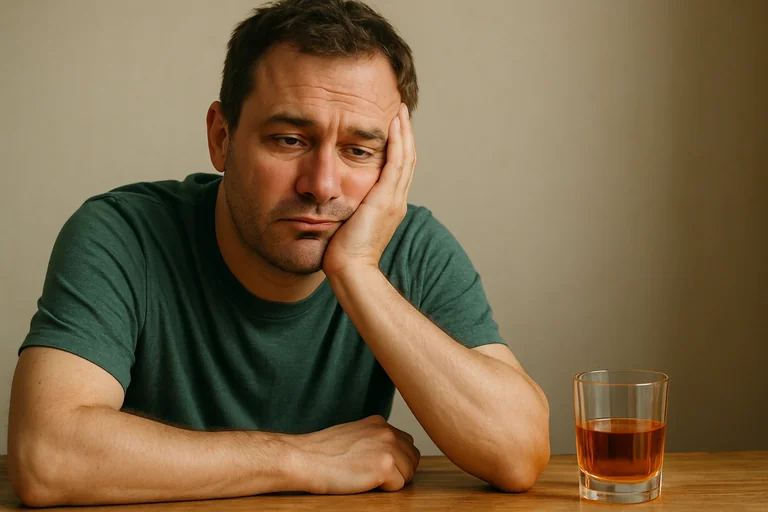A 2 minute assessment to get a personalized mental health or alcohol recovery plan.
Quitting or cutting back on alcohol isn't a single leap - it's a series of measurable checkpoints that help you plan, spot progress, and avoid common traps.
What You'll Discover:
- How to measure recovery beyond just "feeling better."
- What happens in the first 72 hours and why sleep gets worse before better.
- Fast wins you can expect in the first two weeks.
- How medications like naltrexone change your milestone timeline.
- What to track at 3 months, 6 months, and one year.
- Realistic timelines and systems that make change stick.
- Safety warnings about withdrawal you need to know.
Maybe you've tried to quit or cut back before and felt lost without a map. Or perhaps you're standing at day one wondering what the next few weeks will actually look like. The truth is, recovery isn't about willpower alone - it's about understanding the predictable checkpoints your mind and body will hit along the way.
This guide lays out what most people encounter in the first 72 hours, the first two weeks, the next three months, and the first year. You'll see what typically improves when, what risks to watch for, where medications fit in, and how to track success with objective markers - not just vibes.
What "Recovery" Actually Means and How to Measure It
Before we dive into timelines, let's get clear on what we're measuring.
Understanding Alcohol Use Disorder (AUD)
Alcohol Use Disorder is diagnosed when 2 or more of 11 symptoms occur within 12 months. Severity is based on how many criteria you meet: 2 to 3 is mild, 4 to 5 is moderate, and 6 or more is severe, according to the DSM-5-TR. The NIAAA summarizes these criteria in plain language you can use as a self-check as you progress.
Risky Drinking Levels
Even if you don't meet criteria for AUD, certain drinking patterns carry significant health risks. Binge drinking means reaching a BAC of 0.08% - typically 4 or more drinks for women or 5 or more for men in about 2 hours. Heavy drinking is 8 or more drinks per week for women or 15 or more for men. Most heavy drinkers also binge, according to NIAAA data.
These aren't arbitrary numbers - they're helpful "red lines" for your calendar and habit tracker.
The Milestone Mindset
Think of recovery as progress on two axes: fewer (or no) heavy and binge episodes plus fewer (or no) AUD criteria met. Track both. When you can look back at your calendar and see that you've gone from 12 binge episodes in a month to zero, that's concrete progress you can point to.
Safety First: Who Should Not "White-Knuckle" the Early Days
Before we talk about what to expect, let's talk about safety. If you've been drinking heavily, do not stop suddenly without medical guidance.
Alcohol withdrawal can escalate to seizures or delirium tremens (DTs) and can be life-threatening. Seek urgent care if you have a history of seizures, prior severe withdrawal, heart disease, or if you develop confusion, agitation, fever, or uncontrollable tremors.
If you're unsure whether it's safe to stop on your own, talk to a clinician before your quit date. For more detailed information on withdrawal timelines and red flags, read our guide on how long alcohol withdrawal lasts and when to seek emergency help.
This isn't about being dramatic - it's about being smart. Supervised withdrawal is always safer than going it alone if you've been a heavy drinker.
The First 72 Hours: Stabilization and Sleep Turbulence
The first three days are about getting through the acute phase. Here's what to expect:
What Often Improves
Hydration and Energy - As alcohol leaves your system, your body begins to rehydrate and your energy starts normalizing. You might notice you're not waking up dehydrated with a pounding headache.
Cravings May Fluctuate - Expect cravings to come in waves. Plan for them by changing your environment: remove alcohol from your home, alter your usual routines, avoid your typical drinking triggers.
What Can Feel Worse Before It Gets Better
Sleep Will Be Rough - This is the big one that catches people off guard. Your sleep can be choppy, fragmented, and full of vivid, intense dreams. Why? Alcohol suppresses REM sleep early in the night. When you stop drinking, your brain experiences REM rebound - it tries to "catch up" on all the REM sleep it's been missing.
A study published in PMC explains that during withdrawal and early abstinence, you'll have restless, dream-heavy nights before your sleep architecture settles. This is normal and temporary.
How to Help It Along
Treat sleep like rehabilitation:
- Keep your room cool and dark
- Stick to a consistent schedule
- No screens at least an hour before bed
- Cut off caffeine 8 or more hours before bed
- If anxiety spikes and wakes you, pair a breathing exercise with a boring audiobook or podcast to drift back to sleep
Don't judge your recovery by these first few nights. Push through - it gets better.
Days 4 to 14: Fast Wins You Can Feel
This is the "wow" window for many people. The acute withdrawal phase has passed, and your body starts rewarding you with noticeable improvements.
Common Milestones
Sleep Quality Improves - You'll start experiencing fewer early-morning wake-ups as your REM sleep stabilizes. You're still not at 100%, but it's noticeably better than days 1 to 3.
Skin and Eyes Look Brighter - Inflammation drops. People around you might even comment that you look healthier. The puffiness and redness start to fade.
Morning Clarity and Energy - That fog that used to hang over your mornings? It's lifting. You wake up actually feeling rested.
Cravings Drop - Cravings become less intense and don't last as long, especially if you add medication support (more on that in a moment).
Biomarkers Start to Budge
If you've had abnormal liver enzymes, markers like GGT (gamma-glutamyl transferase) often begin to decline within weeks of cutting back or abstaining. Research in Alcohol & Alcoholism found that even in moderate drinkers, one month of abstinence measurably improved GGT levels.
These are motivating, lab-based milestones you can track with your clinician. Seeing those numbers improve is powerful proof that your body is healing.
Medication-Assisted Milestones: An Evidence-Based Shortcut
If cravings are derailing your progress, naltrexone is a well-studied option that can change your trajectory.
When taken correctly - either daily or targeted before drinking situations - 50 mg of oral naltrexone significantly reduces the chances of returning to heavy drinking. A large JAMA systematic review found a number needed to treat of about 11 for preventing return to heavy drinking. That means for every 11 people who take naltrexone, one additional person will avoid relapse compared to those not on medication.
A Cochrane review echoed these findings, showing reduced heavy drinking risk and fewer drinking days overall.
These aren't magic pills, but they materially shift the odds in your favor, especially in the first year. Curious about how it actually feels and how long most people stay on it? Read our plain-English guide to how naltrexone stops cravings and our explainer on how long you need to take naltrexone to reach durable results.
Milestone to Log: Fewer "I caved" nights per month after starting medication, alongside shorter craving windows.
Weeks 3 to 8: Consolidation - When Habits Matter More Than Motivation
By week three, the initial excitement and fear have worn off. This is where systems become more important than motivation.
What to Expect
Sleep Keeps Smoothing Out - Most people notice they fall asleep faster and wake fewer times, though some lingering "REM catch-up" can continue. Your sleep is normalizing, and the sleep architecture disruption from years of drinking is finally healing.
Mood Steadies - As blood sugar swings and inflammation settle, your mood becomes more stable. You're not riding the emotional rollercoaster of hangovers and withdrawals.
Social Confidence Grows - You've successfully navigated several "alcohol-light" or "alcohol-free" outings. Each one builds confidence for the next.
Systems That Make It Stick
This is where you need practical strategies:
Default Swaps - Find non-alcoholic options you actually enjoy. This might be NA beer that doesn't taste like cardboard, or a seltzer-and-bitters ritual that feels special.
If-Then Plans - Pre-decide your responses. "If I'm offered a second drink, I order my non-alcoholic option." "If I feel a craving after work, I go for a walk instead of stopping at the store."
Add Friction - Keep no alcohol at home. Switch to cash-only budgets for going out. Make the easy choice the right choice.
Milestone to Log: 30 days without a heavy or binge episode, 5 or more social events navigated on your terms, and a sleep score trend that's clearly up versus week one.
Months 3 to 6: Performance Gains and Identity Shift
By three months, you're not just "not drinking" - you're becoming someone different.
What People Report
Cognitive Uptick - Focus, memory, and decision-making speed improve as sleep, nutrition, and daily rhythms stabilize. That mental fog you thought was just "getting older"? It was the alcohol.
Fitness and Labs Improve - Resting heart rate drops, blood pressure normalizes, and liver enzymes frequently move in the right direction. Your body is thanking you.
Cravings Become Rarer - They're more situational now - maybe after a fight, or at celebrations - rather than constant background noise.
A Critical Fork in the Road
If you're trying to moderate rather than abstain completely, you'll know by now whether your rules actually hold under stress. If "just one" keeps turning into several more, it's time to consider a sustained abstinence block plus medication support.
Be brutally honest with yourself. Mindful drinking requires real discipline. If you don't have it yet, that's okay - but acknowledge it and adjust your plan.
Milestone to Log: 90 days without heavy drinking (or 90 days fully alcohol-free), labs in normal range per your clinician, and clear rules you actually keep.
Months 6 to 12: Protecting Your Compound Interest
Data and clinical experience agree: the first year carries the highest relapse risk. This is exactly why adding supports during this stretch pays massive dividends.
Medication (when indicated), therapy or coaching, and sleep-first routines reduce high-risk "spikes" and help you turn progress into permanence.
Build "Moats" Around These Areas
Sleep (Still the Keystone) - Earlier dinner and last drink if you're moderating, phones out of the bedroom, consistent wake time even on weekends. Sleep is your foundation. Protect it fiercely.
Stress Relief - Make it scheduled, not incidental. Movement, connection with friends, time in nature - these can't be "when I have time" activities. They need to be calendar events.
Identity - You're becoming the person who trains early, who leaves events according to plan, who orders their drink first so others follow your lead. Own it.
Year-One Milestone: Conduct an annual review of your calendar. Count your heavy and binge-free months. Review your labs. Go back to that AUD criteria checklist you started with and count how many you've retired. This is your evidence.
A Realistic Milestone Timeline
Every path is personal, but this example shows how to make milestones observable and trackable:
Day 0 (Planned Start)
- Told partner or close friend about your plan
- Removed alcohol from home
- Lined up non-alcoholic swaps
- If needed, spoke to clinician about safe quit plan and medication screening
Day 3
- Experienced rough sleep with vivid dreams
- Used breathing exercises and audiobook to return to sleep
- Reminded yourself this is normal and temporary
Day 7
- Successfully navigated first weekend events
- Zero binge nights
- Started naltrexone if chosen, or doubled down on environment and routine changes
Day 14
- Noticeably better morning energy
- Cravings less frequent and intense
- Ordered labs to establish new baseline (including GGT)
Day 30
- Zero heavy-drinking episodes this month
- Sleep metrics clearly improving
- GGT trending down versus baseline
Day 90
- Three months without heavy drinking (or completely alcohol-free)
- Clear, written rules for holidays and vacations
- Two go-to non-alcoholic options that feel celebratory
Day 365
- Year-in-review shows steady adherence, better labs, stronger identity and supports
- Decision point: continue current plan or adjust based on goals and evidence
How to Track Your Recovery Beyond "How I Feel"
Feelings matter, but data doesn't lie. Here's what to track:
Calendar Streaks - Mark heavy-free days and alcohol-free days separately. Both matter. Use CDC and NIAAA thresholds for objectivity.
AUD Criteria Score - Re-score monthly using the NIAAA criteria. Celebrate each criterion you no longer meet.
Sleep - Use a basic log or wearable tracker. Aim for fewer awakenings and a steadier wake time. Understand that REM rebound in the early days is normal.
Labs - Discuss timing with your clinician. GGT can show meaningful improvement within a month of abstinence.
Cravings - Rate intensity on a 0 to 10 scale and duration in minutes. Note what helped reduce them.
When Moderation Is the Goal: Guardrails That Work
If you're aiming to drink moderately rather than quit completely, you need stricter rules, not looser ones.
Personal Thresholds
- Never more than 1 drink per occasion the first month after a reset
- Never drink on consecutive days
- Never drink when tired, hungry, or angry
Event Scripts
- Order your drink first so you set the tone
- Plan your exit time in advance
- Bring or identify your favorite non-alcoholic option
Monthly Audit
- If any heavy or binge episodes occurred, switch to abstinence plus medication for 30 to 90 days
Moderation is harder than abstinence for many people. If you find yourself constantly negotiating with yourself about "just one more," that's valuable information.
Sleep Improvements and Early Challenges
Often, yes. Alcohol distorts your sleep architecture. When you stop, REM rebound and fragmented nights are common for a short stretch. It stabilizes - protect your sleep routine and give it time.
Timeline for Liver Marker Improvement
It varies by individual and drinking history, but GGT often improves within weeks to a month of not drinking. Pair lab tests with calendar data so you can see behavior change turning into biology change.
Medication and Personal Agency
Absolutely not. Medications like naltrexone reduce the pull of heavy drinking and give your behavioral tools - your plans, your new identity, your support systems - room to work. They're evidence-based and often most helpful in the first year of recovery.
Handling Slips and Setbacks
Log what happened, when it happened, and why. Tighten your plan for that specific context, and get back to your next milestone. A single episode doesn't erase your overall trend. Recovery isn't about perfection - it's about direction.
Safety and Medical Guidance for Stopping Alcohol
If you've been drinking heavily or had prior severe withdrawal, do not stop abruptly without medical guidance. Withdrawal can be life-threatening. Seek care and make a safe plan with a clinician who understands alcohol withdrawal.
Take the Next Step
Recovery is a series of milestones, not a single moment. By tracking concrete markers - your calendar, your labs, your AUD criteria score - you can see progress even on days when motivation is low.
Ready to get a clearer picture of where you are right now? Get a private alcohol risk assessment aligned with DSM-5-TR criteria and learn about clear next steps including self-guided reduction strategies, clinician options, and medication-assisted treatment.
Start here: Take the Alcohol Use Assessment




